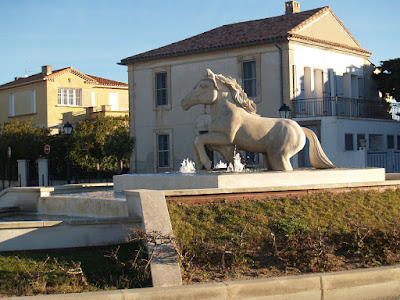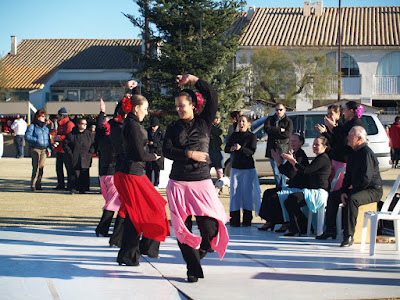Our trip through Provence comes to an end. The last stage is devoted to the Camargue that, despite being part of the same region, desolate landscapes, wetlands and so specific personality are a world apart that much different from the picture of Provence. The mountains, forests of oak trees and lavender fields give way to Great Plains where native white horses graze and bulls, both symbols of the Camargue. Located between the departments of Vaucluse and Gard, is the largest river delta in western Europe. Geographically it is wedged between the two arms of the Rhone Delta and the Mediterranean, limiting almost triangular shape on the west by the Petit Rhone and the East with the Grand Rhone.
Because of its climate and characteristics, hosts a large number of birds, among which the pink flamingo who spends winters in his extensive swamps. But his image is associated not only birds, also the horse and the bull.
In muddy grass horses are bred half-wild bulls and Camargue.
In muddy grass horses are bred half-wild bulls and Camargue.
celebrities are said white horses of Camargue wild horses descended from those who lived in Gaul in prehistoric times and appear in paintings Lascaux cave, others, however, attributed to a North African origin and there are those who speak of Tibetan origin. They are miniature horses, with a back up to 145 cm high, introduced primarily in agriculture but is now used for tourist rides. Its wide and hard hooves, which do not need shoes, are ideal for wetlands. It is curious why these horses are born with black hair and six months ago, the coat takes the characteristic silver-gray color.
The bulls, with its lyre-shaped horns, are raised for Provencal bull called férias or camargaises courses, which are not killed the animal.
Jeans, gardians , with its typical wide-brimmed black hats are excellent horsemen guarding herds of bulls and horses, the Manader , mounted on horseback.
For crops, rice is the product best adapted to the conditions of the Camargue and has become the first European producer of rice.
Jeans, gardians , with its typical wide-brimmed black hats are excellent horsemen guarding herds of bulls and horses, the Manader , mounted on horseback.
For crops, rice is the product best adapted to the conditions of the Camargue and has become the first European producer of rice.
The two largest cities in the region are Les Saintes-Maries-de-la-Mer and beautiful walled city of Aigues Mortes .
is a popular tourist area that offers a variety of activities and long beaches of golden sand. Although the supply is ample, in the summer when the French down south in search of their much longed sun can be difficult to find accommodation without prior reservation.
in winter is another story and you can enjoy the landscape with few hassles.
It reminded me in many ways the Delta del Ebro, perhaps through the villages of whitewashed houses on one level or perhaps by the tracts of land where there is not a sad hill.
a few miles of leaving Arles and change the landscape in a clear and begin to see the great plains. Nor take us long to see horses and bulls, many more horses than bulls. The road is full of style accommodation gîtes or chambres d'hostes , which would become the Bed & Breakfast or our cottages which also offers sale of local products and horseback horse. We arrived
Saintes-Maries-de-la-Mer and first it seems that the people themselves do not have too many tourist attractions, highlighting only the beautiful belfry belfry of the parish church and some corners with sculptures that emphasize the elements of the region: a white horse, a bull, a chopper, flamingos ...
Saintes-Maries-de-la-Mer and first it seems that the people themselves do not have too many tourist attractions, highlighting only the beautiful belfry belfry of the parish church and some corners with sculptures that emphasize the elements of the region: a white horse, a bull, a chopper, flamingos ...
know if it's not the cold or why it's Saturday but the streets are empty and locals still closed.
We walked to the small port where the bullring. Judging by the large number of restaurants, cafes and bars I get the idea how this port must be summer, but at this morning we see a fisherman just tinkering with their networks. The port continues with a long beach. It seems that the air blowing is no coincidence, since the beach is full of windbreaks where shelter.
Les-Saintes-Maries-de-la-Mer must her name to Mary St. James, sister of the Virgin Mary, Mary Magdalene and Mary Salome, mother of the Apostles John and James. Also the Egyptian servant Sara it is related to the people. According to legend, 40 feet in the year, those Christians came safely to the coast from Palestine to board a small boat without a sail. In gratitude, erected a shrine to the Virgin Mary and Saint James, Mary Salome and Sara stayed to evangelize Camargue. After his death, the three women characters became cult and established a pilgrimage to this place. In the ninth century and the threat of the Saracens, a fortified church was built to replace the original humble chapel. It resembles a powerful stronghold because of the parapet that surrounds the building, which was added later in the fourteenth century.
Since the nineteenth century houses the shrines of the three Marys found in a crypt in the choir for that purpose.
The maid Sara is also venerated as patron saint of the gypsies as tradition says belonged to this ethnic group and is the subject of a great annual pilgrimage that lasts two days and two nights, 24 and 25 May.
We headed Aigues Mortes which is just over 30 miles. We drove on a quiet local road that allows us to enjoy the scenery and stopping to get closer to the herd of horses.
Aigues-Mortes is located in the middle of an area of \u200b\u200bsalt ponds and canals in the Rhone blends with the sea. Port city in origin, currently is located inland, eight miles from the coast. The town was founded in 1241 and was built on marshland, salt marshes and lagoons so its very name "dead water" refers to the place.
French King Louis IX the Holy acquired land to the monks with the intention of founding a proprietary port on the Mediterranean. In 1248, 35,000 men in 1500 ships sailed way of the Seventh Crusade to free Jerusalem.
French King Louis IX the Holy acquired land to the monks with the intention of founding a proprietary port on the Mediterranean. In 1248, 35,000 men in 1500 ships sailed way of the Seventh Crusade to free Jerusalem.
is a beautiful town surrounded by walls that have remained almost intact. The city was fortified in 1272 and was finished by the end of the century under the reign of Philip IV the Fair. Barely half a century later, the channels began to be covered with sand and the port was leaving the city practically unusable forgotten. Thanks to this has been perfectly preserved walled enclosure. Across the entrance are found intertwined streets reaching the central square with a statue of St. Louis, patron of the city. We found a lot more room than in Saintes Maries and its streets are lined with souvenir shops and products from Provence, and Marseille soap lavender, olive oil, wine and crafts.
survive some examples of French donjon, ie the tower floor. On the one hand it is a fortress, while the other houses a living area.
survive some examples of French donjon, ie the tower floor. On the one hand it is a fortress, while the other houses a living area.
The city is a regular rectangle about 570 by 300 meters long with round towers that protect the wall in different sections, from which archers could make any aggressor white.
Horses have always been linked to the history and legends of ancient Aigues-Mortes. Children are told that if they misbehave, will come the dreaded Lou Drape and taken away. This is a horse that roams the night in the walled area and croup can be extended to accommodate 100 children who were naughty take to the marshes for food.
We leave a door of the wall and spotted a line of white hills: it is of the saltworks. It is the salt-producing area around the country and the region's main industry after tourism. The Peccais salt, were owned by the Abbot of Psalmody and the lords of Uzès and Almargen. In 1275, Philippe Le Bel compared to Uzès Bermon Peccais land. In the late eighteenth century there were 17 salt pans, of which the Abbot and the salt of the Knights of St. John of Jerusalem were exploited by the Church, while the rest were operated by different owners. In 1856, the Company Salines du Midi, buy the salt and founded the company name "Company of Salinas de Midi (CSM)."
of Aigues Mortes we went to the village of Le Grau du Roi where we saw a large group of flamingos.
Back in Saintes Maries de la Mer with the intention of eating and now it seems that everyone has woken up: many people on the street and the restaurants full. The street market located in the Hotel de Ville Square is already reaping their jobs. Camargue eat a big salad, some delicious mussels and a mellow stew of bull meat, the house specialty and region, of course.
Upon leaving the restaurant, we heard music coming from the Seville Plaza del Ayuntamiento. A group of gypsies have set up a show and within minutes you have made your audience. In May, when thousands gather to worship their patron Saint Sara, you must mount a soiree worthy of admiration. Meanwhile, a group of grandparents outside the fun, play their game of petanque, the French national sport, doing the minimum for the dances and songs of the gypsies. With this joy in the body that spread the Seville, we took leave of Saintes Maries and the Camargue to undertake the journey back home.
Back in Saintes Maries de la Mer with the intention of eating and now it seems that everyone has woken up: many people on the street and the restaurants full. The street market located in the Hotel de Ville Square is already reaping their jobs. Camargue eat a big salad, some delicious mussels and a mellow stew of bull meat, the house specialty and region, of course.
Upon leaving the restaurant, we heard music coming from the Seville Plaza del Ayuntamiento. A group of gypsies have set up a show and within minutes you have made your audience. In May, when thousands gather to worship their patron Saint Sara, you must mount a soiree worthy of admiration. Meanwhile, a group of grandparents outside the fun, play their game of petanque, the French national sport, doing the minimum for the dances and songs of the gypsies. With this joy in the body that spread the Seville, we took leave of Saintes Maries and the Camargue to undertake the journey back home.
hidden surprises Camargue that surprises visitors to display what it is: simple, authentic, unpretentious, with traditions and a unique culture, friendly people and friendly, partygoers and good living.































0 comments:
Post a Comment